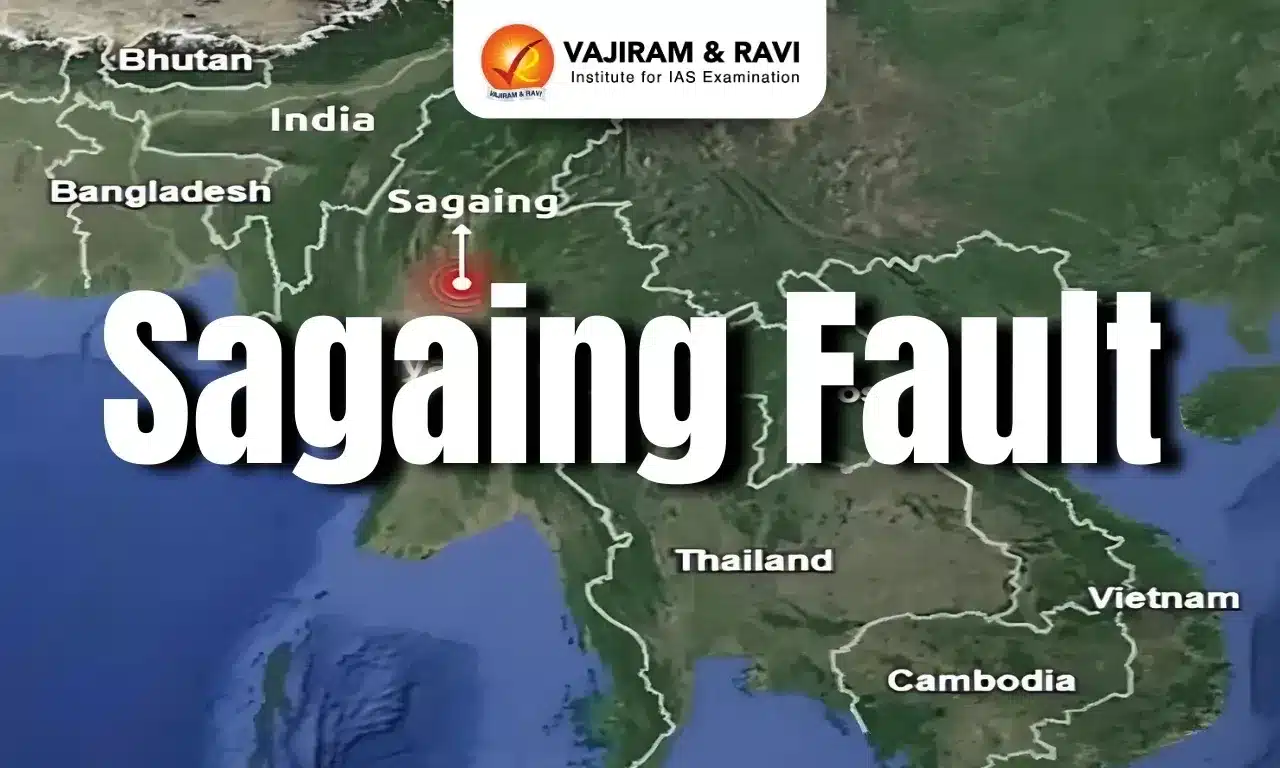Sagaing Fault Latest News
The recent Myanmar earthquake occurred due to strike-slip faulting along the Sagaing Fault, which separates the Indian Plate from the Eurasian Plate.
What is the Sagaing Fault?
- The Sagaing Fault is a major active tectonic boundary running north to south through Myanmar, separating the Indian and Eurasian Plates.
- It is one of the longest and most active strike-slip faults globally, extending 1,500 km from the Andaman Sea in the south to the Eastern Himalayas in the north.
- The Indian Plate is moving northward, causing stress buildup along the fault, leading to large earthquakes over time.
Types of Faults and Their Role in Earthquakes
- Faults are fractures in the Earth’s crust where rocks move due to tectonic stress. When stress accumulates beyond a critical limit, energy is released as seismic waves, causing earthquakes.
- The main types of faults include:
- Normal Fault: The hanging wall moves downward relative to the footwall, common at divergent boundaries. (Example: East African Rift Valley, Basin and Range Province in the U.S.)
- Reverse Fault: The hanging wall moves upward due to compression forces, occurring at convergent boundaries. (Example: Himalayas, Rocky Mountains)
- Strike-Slip Fault: The horizontal movement of fault blocks occurs with minimal vertical displacement, typical of transform boundaries. (Example: Anatolian Fault in Turkey, Sagaing Fault in Myanmar)
- Transform Fault: A specific type of strike-slip fault where tectonic plates slide past each other. (Example: San Andreas Fault in California)
Sagaing Fault FAQs
Q1. What is the Sagaing Fault?
Ans. A major active fault line in Myanmar responsible for significant seismic activity.
Q2. Why is the Sagaing Fault important?
Ans. It is one of the most seismically active regions in Southeast Asia.
Q3. What type of fault is the Sagaing Fault?
Ans. It is a right-lateral strike-slip fault.
Source: TH
Last updated on November, 2025
→ Check out the latest UPSC Syllabus 2026 here.
→ Join Vajiram & Ravi’s Interview Guidance Programme for expert help to crack your final UPSC stage.
→ UPSC Mains Result 2025 is now out.
→ UPSC Notification 2026 is scheduled to be released on January 14, 2026.
→ UPSC Calendar 2026 is released on 15th May, 2025.
→ The UPSC Vacancy 2025 were released 1129, out of which 979 were for UPSC CSE and remaining 150 are for UPSC IFoS.
→ UPSC Prelims 2026 will be conducted on 24th May, 2026 & UPSC Mains 2026 will be conducted on 21st August 2026.
→ The UPSC Selection Process is of 3 stages-Prelims, Mains and Interview.
→ UPSC Result 2024 is released with latest UPSC Marksheet 2024. Check Now!
→ UPSC Prelims Result 2025 is out now for the CSE held on 25 May 2025.
→ UPSC Toppers List 2024 is released now. Shakti Dubey is UPSC AIR 1 2024 Topper.
→ UPSC Prelims Question Paper 2025 and Unofficial Prelims Answer Key 2025 are available now.
→ UPSC Mains Question Paper 2025 is out for Essay, GS 1, 2, 3 & GS 4.
→ UPSC Mains Indian Language Question Paper 2025 is now out.
→ UPSC Mains Optional Question Paper 2025 is now out.
→ Also check Best IAS Coaching in Delhi

















